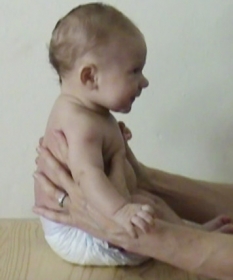This is the third post in a series of 3 posts describing assessment of the infant during the 2-3 month period.
In this post I describe how to asses an infant's ability to control the head both in the pull-to-sit test and when supported in sitting.
Pull-to-sit
The infants response to the pull--to-sit maneuver is often used as a test when assessing motor development. It provides a good measure of the infant's neck muscle strength as well as the development of effective anticipatory postural responses
During the 2-3 months period infants start to anticipate the impact on the head of being pulled into sitting, and start to activate the neck flexor muscles in preparation for the being lifted.
At this stage they are able to hold the head in line with the trunk during the pull-to-sit maneuver.
Once the trunk is upright the infant is able to hold head in line with the trunk for a short period of time, especially when supported by visual attention to an interesting event (such as an animated face).



Method
To assess the PTS response, grasp the infant's hands and slowly pull the infant into the sitting position.
Typically developing infant
- Infant holds the head in line with the trunk
- Starts to brace the arms to assist with the PTS maneuver.
- Hip flexion is initiated.
Atypical development
- Infant does not anticipate the PTS maneuver - no anticipatory neck flexor muscle activity.
- The head lags behind trunk as the infant's trunk is lifted.
- The UE do not flex to assist
- No associated movement in the LEs
Trunk control with pelvic level support
During the 2-3 month period the infants learn to support the trunk in a semi-erect position for longer periods of time when supported in sitting. This is done by activating the neck and trunk extensors.
For subscribers: Development of Sitting with videos


Method
To assess sitting with support, let the infant sit on a firm surface and provide manual support around the pelvis and hips.
Typical development
- The infant is able to extend the neck and spine - neck and trunk extensor muscle activity is supported by shoulder retraction.
- The infant can maintain the trunk extension for a brief period of time.
Atypical development
- Infant is not able to extend the trunk when in sitting with support around the pelvis and lower trunk region.
- Infant flexes the trunk.
Head control in sitting: with support around the torso
When provided with support around the torso, the 2-3 month old infant is able to stabilize the head on the upright torso for extended periods of time. The ability to stabilize the head on the trunk is enhanced when the infant pays visual attention to an interesting object or event at face level that encourages visual stabilization.
The infant is also able to maintain an erect position of the head when the trunk is tilted backwards or forwards.
For subscribers: Development of Sitting with videos


Method
Let the infant sit on a firm surface with manual support around the torso. With the infant facing you, you can align your face level with the infant's in order to provide a stimulus for sustained visual focus.
Next tilt the infant a small way forwards and backwards to assess the ability to maintain the face erect when the trunk is tilted.
Typical development
- Infant is able to hold the head erect for an extended period of time.
- Infant maintains the face erect when the trunk is tilted forwards or backwards.
Atypical development
- Infant not able to hold the head erect even for a brief period of time.
- Infant does not right the head when trunk is tilted backwards, forwards or laterally. .
Assessment during the 2-3 month period